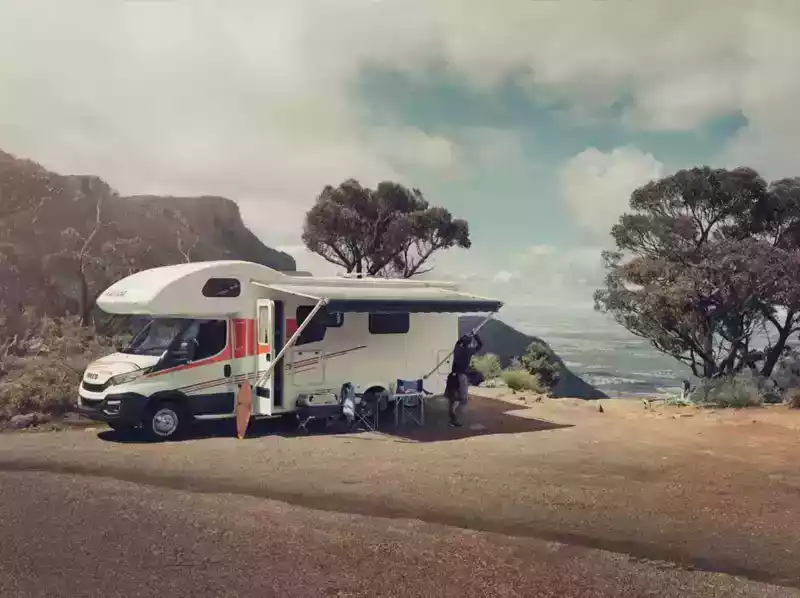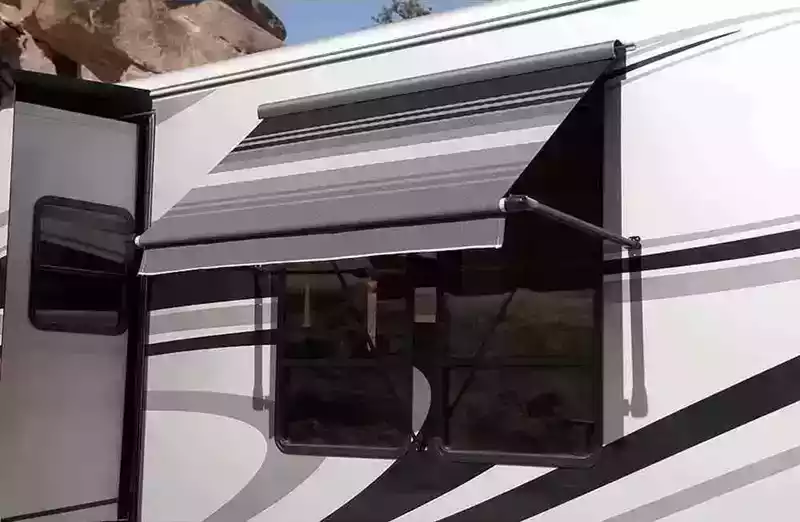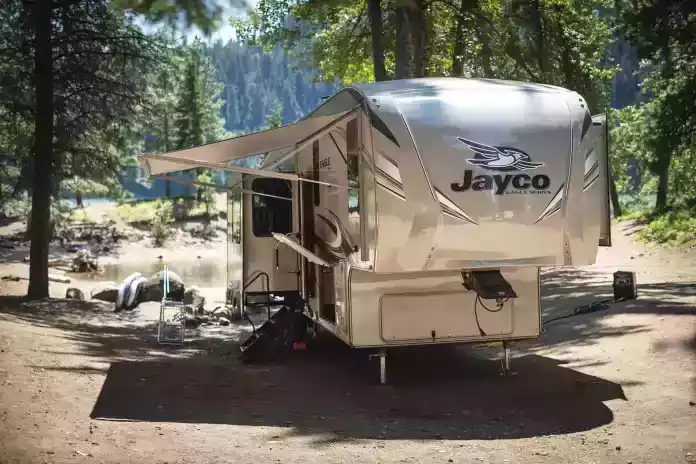Table of Contents
RV awnings are a great addition to any trailer, motor home, caravan, or camper van set up. They provide an extra layer of protection from the elements, such as rain and wind, while allowing you to enjoy the outdoors in comfort. Awnings for caravans and camper vans come in many different shapes, sizes and materials so that you can choose one that best suits your needs.
The main benefits of having awning include providing shade from direct sunlight during summer months, additional space when camping out and privacy when necessary. Additionally, they can also help protect against bad weather conditions like heavy rain or strong winds.
Identifying and Selecting an Awning
Types of RV Awnings
There are several awning styles and configurations available for trailers, caravans, and camper vans. Here are some of the most common ones:

Manual Vertical Arm Patio Awnings: These awnings have two arms that mount down the side of the coach, giving them their name. They can be easily extended or retracted as needed. Modern versions typically have manual operation with a spring assisting the deployment and stowing processes. They have a latch that locks the awning roller in the out position when parked and secures the roller to the side of the RV when traveling.

Power Vertical Arm Patio Awnings: These are motorized versions of the vertical arm awning. Instead of having to manually deploy them, they are connected to the 12 volt power and can be extended or retracted with the push of a button. A power awning is a great RV or camper upgrade for comfort and convenience.

Box Awnings: Box awnings are stored in metal cannisters that attach on the roof or just below the roof of the trailer or motorhome. the front of the cannister attacches the awning fabric holding the leading edge. and the roller stays stationary in the cannister. They also can be power or manual and are supported by manual arms that clip into brackets lower on the coach body. They are the awning of choice for Camper vans, but other RV types use them as well.

Bag Awnings: Bag awnings are usually used on Pop-up camper trailers. The awning fabric and frame stow in long vinyl bag that attaches to the side roof of the trailer. When arriving at the campsite, the bag is unzipped and the fabric rolled out. Then, the awning arms are extended and attached to brackets lower on the trailer body to support the awning. These awnings are lightweight and easy to set up.

RV Slide Out Awnings: These are roller awnings that cover the top of slideout rooms when they are extended. RV slide-out awnings prevent water, dirt and other debris from penetrating the inside or the coach through gaps in the slide out’s seal.

RV Window Awnings: These awnings are specifically designed to cover windows and provide shade and privacy.
Choosing the Right Awning
When choosing an awning for your RV, trailer, caravan, or camper van, there are several factors to consider:
1. Size: Measure the area where you plan to install the awning to ensure a proper fit. Consider how much shade or coverage you need and choose an awning size accordingly. You must also have solid anchor points at the floorline and roofline (and vertically for power vertical arm awnings) that connect to a solid part of the coach structure.
Awnings are always measured from the center of one arm to the center of the other arm and are usually sized to the exact foot. (13′, 14′, 15′ etc.) This means that you also have to have free vertical space at the point where you are going to install the arms. You won’t want a stowed awning arm on top of a window, water heater, storage door, etc.
2. Material: Awnings can be made of various materials, the most common being vinyl. Acrylic fabrics are available from some manufacturers and they are more luxurious, with a linen type feel to the fabric. However, they are about 50% more expensive in terms of fabric costs. A small number of awning makers use polyester as well, but it is not as common. Vinyl is recommended, it is the most durable.
Failing an adverse weather event, you should expect 10-15 years life from a properly cared for vinyl awning fabric. They can be classified as single sided or double sided vinyl fabric. Single sided vinyl fabric has the color pattern only on the upper surface, while double sided vinyl fabric has the same color pattern underneath.
3. Functionality: Decide if you want the convenience of a push-button electric RV awning, or if a manually deployed version is sufficient. Consider getting an awning that has adjustable pitch on it so that you can lower one end for better drainage during rain showers.
4. Installation: Some awnings require professional installation, while others can be easily installed by yourself. Consider your DIY skills and the complexity of the installation process before making a decision.
Top awning brands to consider are Solera RV Awnings (by Lippert), Dometic and Carefree RV Awnings. All of these companies offer awnings for sale that are made in North America. There are other brands that you will find in the market that are less expensive and made offshore, but they will not last. You may save money in the short term, but you will likely be replacing the awning within a year or two.
Awning Care and Installation
Maintenance and Care
Regular cleaning and inspection of your awning is important to ensure that it is always in the best condition possible. Cleaning should be done with mild soap and warm water, as harsh chemicals may cause damage to the material or components. It’s also important to inspect all parts for wear and tear, such as fraying fabric covers or loose mounting hardware. If any issues are found, then they should be addressed promptly before use so that you can avoid any further damage being caused by weather conditions or other external factors.
Another key thing to do is to make sure that the awning is never rolled up wet for extended periods of time. This can cause mold to grow on the surface and can also contribute to rotting the seams on your awing or the material itself, reducing the life of the fabric. If you must roll up a wet awning, make sure you re-deploy it as soon as you can and dry it out before rolling it up again for storage.
Make sure that the awning is always rolled up when you are not at the RV and that you also stow it when a storm is approaching. Most awning damage occurs from extreme wind bending the arms out of shape and it can happen without warning and without time to prevent it. The other big awning killer is from large amounts of water pooling in the fabric and bending (or actually snapping) the aluminum roller. Both these scenarios can be prevented by stowing the awning during storms or absence, saving you thousands of dollars or a frustrating insurance claim.
Over the last few years, awning RV parts, especially individual parts of awning arms, have been discontinued. In many cases, even irreparable damage to a small area of the arm assembly requires replacing the whole awning arm, sometimes both. So it’s important to protect your awning from the elements to avoid paying for expensive replacement awnings.
When repairing an awning it’s important to consider what kind of damage has been done so that you know which methods will work best for fixing it. For instance, if there is an issue with torn fabric then an awning tape may applied while broken metal frames could require replacement. Additionally, some more minor fixes like replacing worn out pull cords can easily be done without any prior experience needed!
It’s also worth noting that whenever performing maintenance on your awning it’s recommended to first consult the manufacturer’s instructions before starting as this ensures proper care is taken when dealing with delicate materials or complex components like motorized systems etc., Doing this not only helps keep your awning in great shape but also extends its lifespan over time meaning more years of happy camping ahead
Installation
Before attempting to install the awning and its components, make sure that everything will fit as intended. If you install the awning and it is not compatible, you may have trouble returning it for refund or exchange. It is also important to thoroughly prepare the area. Make sure that any loose material such as dirt or gravel is removed from the surface where you plan on attaching your awning. It’s also recommended to use a level when positioning your mounting brackets so that they are perfectly aligned with one another. This will ensure that your awning stays secure and operates correctly during extension/retraction.
Once everything has been prepared for installation, it’s time to assemble the various parts of your awning. First start by connecting all the pieces together according to manufacturer instructions before securing them into place using screws or bolts depending on what type you have purchased. Once this is done, attach each component onto the mounting bracket while ensuring there is enough play in between them, so they can move freely without any excess tension being applied which could cause damage over time.
Finally, once everything has been installed properly it’s time for functional checks! Start by running through each step involved in opening and closing your new caravan or camper van awning just like you would do when using it outdoors; checking things like how smoothly pulls cords move and whether fabric covers align properly with roller tubes etc., This ensures that everything is functioning as intended before taking off on an adventure with peace of mind knowing that your setup will be reliable throughout!
Awning Accessories
Awning accessories are essential for enhancing the functionality and convenience of your outdoor living space. Whether you’re looking to add extra privacy, protect yourself from the elements, or secure your awning in place, there are a variety of accessories available to suit your needs. Here are some of the most popular awning accessories:
Awning rooms are a fantastic addition to your awning setup, as they provide extra privacy and protection from wind, rain, and sun. These rooms are typically made from durable materials such as heavy-duty vinyl, which are designed to withstand the outdoor elements. Awning walls come in a variety of sizes and styles, allowing you to customize your outdoor space to fit your preferences. They can be easily attached to your existing awning using zippers or Velcro, providing a seamless and secure connection. Most come with screened windows for light and ventilation, with roll-down privacy panels.

Awning rooms actually extend your RV living space by up to 50% and provide bug free outdoor space for dining, relaxing or sleeping. Whether you’re hosting a backyard barbecue or enjoying a peaceful evening under the stars, awning walls are a versatile accessory that can enhance your outdoor experience.
In addition to awning walls, awning anchors are another important accessory to consider. These anchors are designed to keep your awning securely in place, preventing it from being blown away by strong winds or other weather conditions. Awning anchors come in various shapes, sizes, and materials, allowing you to choose the best option for your specific needs. From heavy-duty steel stakes to spiral ground anchors, there is a wide range of options available to suit different awning types and ground surfaces. By properly anchoring your awning, you can ensure that it remains stable and secure, even in challenging weather conditions.
Awning supports are another accessory that can greatly improve the functionality of the awning on your RV. These poles are used to support and stabilize the awning, providing additional strength and rigidity. Awning poles are typically made from lightweight and durable materials such as aluminum or fiberglass, making them easy to transport and set up. They are adjustable in height, allowing you to customize the angle and position of your awning to suit your preferences. Whether you’re looking to create a shaded outdoor seating area or simply want to extend your living space, awning poles are an essential accessory that can enhance the versatility of your camper awning.

Awning Rafters are used on long awnings to keep awning fabrics raised to aid drainage and prevent damaging water pooling. They extend from the roller to the coach wall just below where the fabric attaches. Some are bowed to raise the fabric more and provide a slope for the water to run off.
If the fabric on your awning wears out, it is very easy to purchase a RV replacement awning fabric. You can use an RV awning replacement fabric from any manufacturer because they are universal. All of the awning roller channels and awning rails (what holds the fabric to the RV) are the same size. If you at all handy, it is not a difficult task replacing RV awning fabrics. There are many Youtube videos showing how to replace RV awning fabrics. Here is one of our favorites:
FAQs
How much is a new awning for my RV?
A complete new quality vertical arm or box patio awning (2023) will run between $US2000 and $2500. Add $500-600 if you want a powered version.
Is an RV fabric or vinyl awning better?
Fabric (usually acrylic) feels nicer and is more luxurious, but vinyl awning fabrics are much more durable.
Are camper awnings worth it?
Absolutely. An awning increases your effective living space in the RV 50% or more, especially if you add an awning room.
Should I leave the awning on my RV out in the rain?
Rain or other precipitation does not hurt awning fabrics, unless the fabric is rolled up wet for an extended period. However, what does in most awnings is the wind associated with storms. So when it is raining, it’s best to retract your awning if possible.
How much does it cost to replace a fabric for a camper awning?
Quality camper awnings run between $US 300-500 in 2023. Less expensive ones are poor quality and cannot be expect to last
Overall, awnings for motorhomes, travel trailers, caravans and camper vans are an must have and an excellent investment for anyone looking to upgrade their outdoor RV setup. They provide additional protection from the elements while also allowing you to enjoy the outdoors in comfort. Plus, they come in many different types, sizes and materials so that you can find one that best fits your needs.
When choosing an awning make sure to measure the area where it will be installed as well as research what type of fabric cover is most suitable for your application before committing to purchase. Finally, when installing or performing maintenance on your awning always refer to manufacturer’s instructions first so that everything is done correctly and safely! With careful consideration and proper care, your complete camper van, trailer, or motorhome awning should last you a long time for years of happy camping ahead!
Awnings are an excellent way to make your trailer, motor home, caravan, or camper van more comfortable and enjoyable. With so many options available, you can find the perfect awning for your vehicle that meets all of your needs. If you’re looking to add a bit of extra space and protection from the elements, look no further than awnings for caravans and camper vans.


